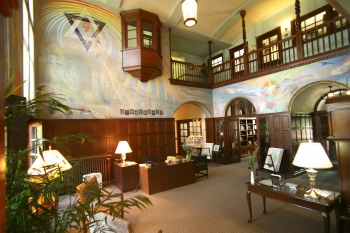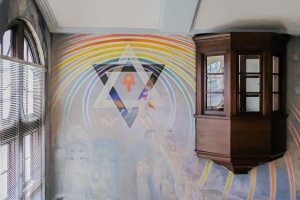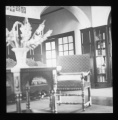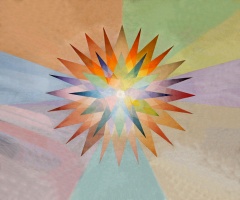Murals at Olcott (art work)
Visitors entering the lobby of the L. W. Rogers Building at the headquarters of the Theosophical Society in America are surrounded by murals painted on all four sides of the lobby. "The Mural of Olcott" is a video presentation of its history and imagery.
The work was painted in 1931-1933 by Philadelphia artist Richard Blossom Farley. At the summer convention in 1930, members authorized the mural project that was proposed by arts patron Georgine Wetherill Shillard-Smith. Mr. Farley visited the headquarters and measured the space. He returned to his studio in Philadelphia where panels were painted, and then he spent several weeks in the Rogers Building while he applied the canvas panels to the walls.
Mrs. Shillard-Smith described the intent of the artist as "Life Aspiring Through the Ages":
Mr. Farley's ambition is to bring into one focus an impartial suggestion of all life, the past and the avenues that lead to the future, the mysteries that drive the onward multifold manifestations, from the atoms to the suns, the oneness of the endless flowers that bloom and fade on the tree of life, and
he believes that the graphic can suggest more than words, for into the million melting tones of color can be woven a fabric too complicated and yet too elemental for words.[1]
Photo gallery
History
Philadelphian Georgine Shillard-Smith was a longtime member of the Theosophical Society based in Wheaton, Illinois. In 1927, work had been finished on a new headquarters building, and Mrs. Shillard-Smith had committed to see it "decorated." The architectural firm recommended waiting for two years before beginning that effort. She was well acquainted with Richard Blossom Farley and his art, and decided that he would be the ideal muralist for the project.
Late in 1929 she brought Blossom Farley from Philadelphia to the headquarters campus, which is known as "Olcott" since it was named in honor of TS Founder Colonel Henry Steel Olcott. By December the painter had measured the spaces in the reception hall and had completed some preliminary drawings. At the Society's summer convention of 1930 he displayed sketches to the membership, and the project was approved in a resolution at the annual meeting.[2] Members immediately subscribed to donate $1415 of the $2500 required for the murals. Mrs. Shillard-Smith led a fundraising campaign to raise the rest – no small feat during the Great Recession. Later that year Mrs. Shillard-Smith reported that he was hard at work in his studio. He painted in oils on canvas that had been cut to fit the spaces. She wrote:
If you could only peep into his studio and see the high wooden frame that he constructed with hinged parts to carry the canvas, see the succession of living models from which he makes drawings for all the figures, and then follow him into the fields where he collects leaves showing the evolution of the leaf form, and then into the Academy of Natural Science, studying prehistoric animals, intent on the accuracy of those forms, and then watch him brooding in the long evenings over the best possible expression in art of his many ideas that he aims to incorporate into this great inspirational work, perhaps you would catch a glimpse of the devotion, skill and persistence necessary to materialize so great a vision...
When one considers the amount of material, work and knowledge required, the price seems inadequate, as Mr. Farley has been working ceaselessly since receiving the commission, and will be much pleased if he can complete it in a year’s time. He must devote himself entirely to this work, not undertaking any other. What a comment this on the small remuneration received by artists! — but how fortunate we are to have so fine an Interpreter of our philosophy...[3]
The artist visited for several weeks in 1931 and installed the first panels on the south wall. Mrs. Shillard-Smith wrote a descriptive article about the mural and the artist in September, 1931, entitled "Life Aspiring through the Ages."[4] The west wall was completed in April, 1933, and by November 2 the east and north panels had been installed. Blossom Farley gave a talk to the Olcott Lodge that day on the symbolism of the murals.[5]The staff and membership have been delighted with the murals ever since.
Description of murals
Shillard-Smith account
After the first mural was installed on the south wall, Mrs. Shillard-Smith wrote:
To the left, the figure of Mother Earth receives the evolving forms of life from the water, but looks upward to the Ancient Symbol set in the rays that sweep down over the steps of effort and doubt, by which men rise to achievement. On these steps are the monuments he builds as he aspires. The Christian Celtic Cross, the Buddha, the Sphinx, are plainly portrayed; while pyramid, temple, church, pagoda, and Runic Stones form a background for priest and crusader. All these are dimly seen behind the principal soaring group, of which Pythagoras and Moses form the center figures. To the extreme right, the Group of Heralds over the doorway is as fine a piece of mural work as Puvis de Chevannes's group in the Library of Boston. This south wall represents man's contribution to the great life symphony, and forms the last and greatest picture of the series of wall spaces Farley plans to paint.
The west wall, which is broken into by two arches, is to have as a center the sun and earth, one carrying the sacred fire towards humanity and the other carrying the sword of destruction to the unfit, through the Reptilian Age. Trilobite and Dinosaur, the development of the single cell through the evolution of simple organisms, fishes and mammals, to man. The east wall, between the windows, will be the wall of the planets and stars. Snowflake forms, spores and pollen grains, as well as the Platonic solids, are used to fill up broken spaces, and give a consciousness of the continuity of circumambient life, never a vacuum, always polarities. The [north wall of the] reception room is to be decorated with flowers and leaf forms in a narrow frieze.[6]
Mural brochure
A brochure describes "The Murals of Olcott" using quotations from the artist:
As you enter the Headquarters Building of the Theosophical Society in America, you discover on the walls of the reception room a series of murals in pastel colors. The basic concept of this series is the mystery and grandeur of evolving life.
Richard B. Farley, the Philadelphia artist whose idea it was to create a truly theosophical sequence depicting the unity of life through changing forms, has shown himself both scholar and artist, and his own words speak for the murals themselves: “Possibly the whole idea of the decoration is arranged about the one thought that Life itself, its balance, is a continually changing performance. . . . Life is all one plan, one balance, with many manifestations, many things right in their place.”
South Wall
At the right of the office window, on the south wall we find ancient symbols, in the order of their painting:
- 1. The swastika, emblem of the whirling, creative fire of creation
- 2. The triskelion, emblem of the Trinity
- 3. The circle (representing water)
The square (representing earth)
The triangle (representing fire)
The crescent (representing air)
- 4. The duality of nature—shown through contrasts: black and white, masculine and feminine, negative and positive forces
- 5. The five platonic solids
The stairs depicted represent the planes of nature up which we climb in consciousness—from brute sensation to human realization.
Every religion is a stage necessary for each phase of the journey, and we discover that worship is suggested by several symbols. Pictured are: the druid, by stone arch and pillar; the Egyptian, by the pyramid; the Chinese is suggested by the temple and pilgrims; the Moslem by camels; the Hindu by elephants. Knights and horse, at the highest point of the mural, are there as related to the Christian Church.
Standing by the River of Life we see also various ecclesiastical figures representing embodiment of spiritual power in evolved men: a Roman Catholic bishop and a Greek Catholic bishop, Thor with antler, a druid priest with golden sickle, and an Indian priest with a snake.
World motherhood is represented by the figure of the mother with the babe in her arms. The lotus flower which the babe carries is the symbol of all perfected creation. We have also in this mural these religious ideas: the tranquility of the Buddha, the might of the Assyrian, the mystery of the sphinx, the faith of the cross. The thought that life and matter are inseparable, ONE, is brought out by the Mayan God and animistic forms.
At the extreme left, in the lower corner, is pictured Mother Nature — basic force — underneath and supporting all creation. Thus we sense the southern mural as stressing two primal factors: religion and life — and these through countless kindred forms, and from ancient times by way of the cross.
Viewing from left to right we follow that varied and ancient symbol, the cross. At the extreme left is the pre-Christian and very early form. This is followed by the Tau, then the Celtic form (in green), and the Maltese form (in rose). The cross of St. Andrew is pictured in green, the Ansated cross in rose, and the Greek cross in blue. The cross of Constantine is next, and then, once more, a pre-Christian cross.
And so we begin to trace, through the magic of form, symbol, and color, a journey of the ages in the evolution of consciousness and form.
West Wall
“The west wall,” to quote Mr. Farley once again, “indicates the following: Beginning with the sun, the lower group is a representation of the forms leading up to humanity, the vertebrates; and the group above shows those which are leading toward insect life. . . . The central design on this wall is the sun from which all life is nourished . . . All forms of early religion contained sun worship. . . . The two figures above are very similar to the idea of . . . creator and destroyer. The figure on the right is the destroyer, destroying the unfit, the forms which will later be reincarnated into fitter shapes . . . . The figure on the left carries the ‘eternal fire’ to humanity, and heralds its approach. Oftentimes there has been a double purpose in this heralding: the bringing of the eternal fires, and also the heralding, by a bird, of the peace which man will finally bring into the world. . . .”
The colors over the sun represent the seven rays; again carried out in the colors of the rays of the spectrum on the wall adjoining.
North Wall
The space on the north wall being limited, the artist here confined himself to elephantine figures as symbolic of the evolution of form. The figures are not of actual evolutionary succession, but the graded similar forms illustrate the principle of the evolution of form.
The leaf-forms which appear in this mural are complementary to the group of symbols which appear just opposite. These leaves remind us that they serve the purpose of collecting chlorophyll, drawing from the sun that energy which is basic to all that lives. Animals do not have this power of extracting energy directly from the sun; thus this possession of chlorophyll seems as good a dividing line as any between the animal and vegetable kingdoms.
The parallel column above the north wall shows pollen grains in their various forms, while the snow crystals are shown in an astronomical design representing the life of the stars in their courses.
East Wall
“At the bottom of the east wall,” Mr. Farley explained, “is the symbol of the sevens — the interweaving of matter, mind and spirit. Spirit is the sharpest, the one that interpenetrates life to the greatest extent. The blunt-pointed one is matter. Each of the three figures returns to the starting point, each completing its cycle, interweaving. . . . If you consider the top line as matter, you complete the cycle of the idea of matter always returning to its appointed place.”
Notes
- ↑ Georgine Wetherill Smith, "Life Aspiring through the Ages," World Theosophy 1:9 (September, 1931), 707-708.
- ↑ "Convention Resolutions" Theosophical Messenger 18.8 (August, 1930), 172.
- ↑ C. Shillard-Smith, "Headquarters Decoration" The Theosophical Messenger 18.12 (December, 1930), 267.
- ↑ Georgine Wetherill Smith, "Life Aspiring Through the Ages," 707.
- ↑ "What Lodges Are Doing" The American Theosophist 21.12 (December, 1933), 284.
- ↑ Georgine Wetherill Smith, "Life Aspiring Through the Ages," 707.












